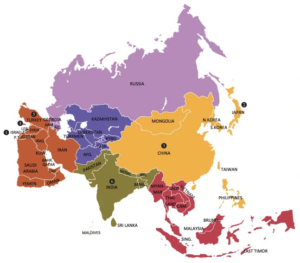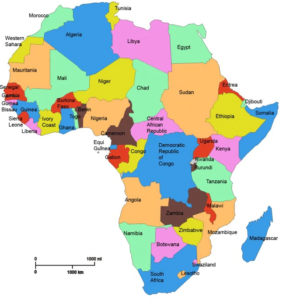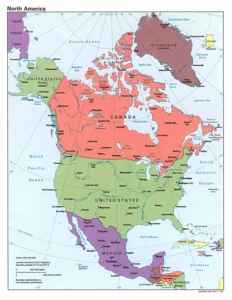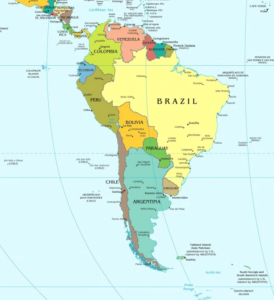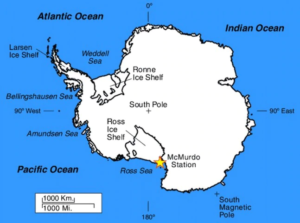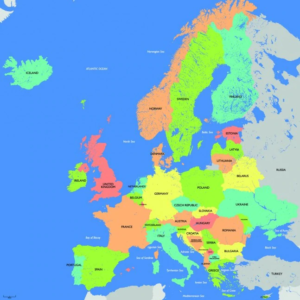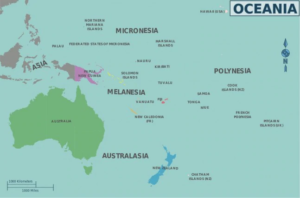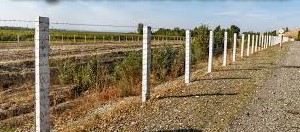Table of Contents
Continents
A continent is a massive area of land that is separated from others by water or other natural features.
“Continent” derives from the Latin terra continēns [terra = “land”, continēns = present participle of the verb contineō = con (“together”) + teneō (“I hold”). The meaning is therefore “land held together” or “connected land.”
The seven continents on Earth are: Africa, Asia, Antarctica, Europa, North America and South America and Oceania/Australia.
All the continents of the world start and end with the same alphabet if you consider North and South Americas as one continent.
Continents together cover one third (29%) of the world, with the oceans covering the other two thirds (71%).
Five of the seven continents are joined by land to another continent, while Antarctica and Australasia are separated from the others by oceans.
Each continent has a wide range of different landscapes, weather, and animal life.
Continents by Size are: Asia, Africa, North America, South America, Antarctica, Europe, Australia/Oceania
Continents by Population are: Asia, Africa, Europe, North America, South America, Australia/Oceania, Antarctica
| # | Continent | Population 2020 | Area (Km²) | Density (P/Km²) | World Pop Share |
|---|---|---|---|---|---|
| 1 | Asia | 4,641,054,775 | 31,033,131 | 150 | 59.54% |
| 2 | Africa | 1,340,598,147 | 29,648,481 | 45 | 17.20% |
| 3 | Europe | 747,636,026 | 22,134,900 | 34 | 9.59% |
| 4 | North America | 592,062,335 | 21,329,979 | 28 | 7.60% |
| 5 | South America | 430,759,766 | 17,461,112 | 25 | 5.53% |
| 6 | Australia/Oceania | 42,677,813 | 8,486,460 | 5 | 0.55% |
| 7 | caribbean | 9,877 | 21 | 470 | 0.00% |
| 7 | Antarctica | 0 | 13,720,000 | 0 | 0.00% |
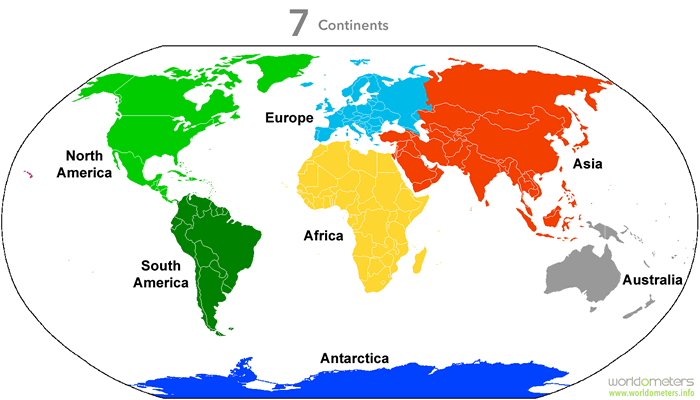
Source: Worldmeters.info
| Continent | Highest Point | Elevation m | Elevation ft | Country | Lowest Point | Elevation m | Elevation ft | Country |
|---|---|---|---|---|---|---|---|---|
| Asia | Mount Everest | 8,848 | 29,029 | China,Nepal | Dead Sea | −427 | −1,401 | Israel, Jordan and Palestine |
| South America | Aconcagua | 6,960 | 22,830 | Argentina | Laguna del Carbón | −105 | −344 | Argentina |
| North America | Denali | 6,198 | 20,335 | United States | Death Valley † | −86 | −282 | United States |
| Africa | Mount Kilimanjaro | 5,895 | 19,341 | Tanzania | Lake Assal | −155 | −509 | Djibouti |
| Europe | Mount Elbrus | 5,642 | 18,510 | Russia | Caspian Sea | −28 | −92 | Russia |
| Antarctica | Vinson Massif | 4,892 | 16,050 | (none) | Deep Lake, Vestfold Hills † | −50 | −160 | (none) |
| Australia | Puncak Jaya | 4,884 | 16,024 | Indonesia (Papua) | Lake Eyre | −15 | −49 | Australia |
Asia
Asia is the largest continent by land area (30% of the world’s land area) and by population (over 4 billion people or 60% of world’s population).
It contains the world’s largest country, Russia, and the world’s two most populous countries, China and India.
The Great Wall of China is the only man made structure that can be seen from space.
Asia is the birthplace of two great ancient civilizations – Harappan civilization and Chinese civilization.
Asia is the birthplace of world’s largest religions of Hinduism, Islam, Buddhism, Christianity.
Continents Images Source: indiatoday.in
Africa
Africa is the second largest by area. Africa is the continent with the most (54) countries.
Since the oldest human fossils have been discovered in Africa, the continent is also called the ‘cradle of humankind’.
The continents terrain was inhabitable and remained unknown for thousands of years, earning it the name of ‘Dark Continent’
Africa is home to the world’s longest river Nile and and the world’s largest desert Sahara.
Africa provides 50% of the world’s gold, 95% of the world’s diamonds and 66% of the world’s chocolate.
North America
North America is home to the largest Christian population in the world.
America was named after the 16th century Italian explorer Amerigo Vespucci and is also known as the “New World”.
Death Valley desert in California has the lowest elevation on the continent at almost 300 feet below sea level.
North America has five time zones and is the only continent with every type of climate.
North America was named after the explorer Americo Vespucci
North America’s population density at 22.9 per square kilometer is the highest
It is home to the largest freshwater lake in the world, Lake Superior.
The world’s third longest river – the Mississippi (3778 km) – is located in North America.
The world’s largest economy, the USA, is a part of North America.
South America
South America is a continent with the world’s longest mountain range – the Andes, world’s highest waterfalls (3,000 feet tall) – the Angel Falls and the world’s driest place Atacama Desert, Chile.
South America is also the home to the mighty anaconda, a huge snake that lives in the wetlands, can swim really well and likes to eat whole wild pigs.
The world’s largest river as per water volume and the second longest (6440 km) — the Amazon — is in South America
The highest volcanoes of the world — Mt. Cotopaxi and Mt. Chimborazo — are found on this continent.
South America has the largest salt lake in the world — Salar de Uyuni (Uyuni salt flats).
Antarctica
There are only research stations for scientists and no permanent settlements.
Antarctica is covered almost completely by ice. 90% of the planet’s ice is located on this continent, which also makes up 60% – 70% of the world’s freshwater supply. It is also called the White Continent or the Frozen Continent.
Antarctica is not only the coldest place on Earth but also the highest, driest, windiest and emptiest.
Before 1840, Antarctica was called ‘Terra Australis Incognita’ (‘the unknown southern land’).
Antarctica sees half a year of light and half a year of complete darkness – summer months of December to February give 24 hours of light, while the winter months of late March to late September are pitch dark the whole day
Summer temperatures in the Frozen Continent are around -35 degree C in the interior and 2 degree C at the coasts.
In the winters, it is -70 degree C in the interior and 2 degree C at the coasts.
Antarctica saw the coldest natural temperature ever recorded on Earth was -89 degree C.
Because of this sort of extreme temperature fluctuations, Antarctica is larger in winters by around 14.2 million square kilometers than in summers due to the ice formation around the periphery.
There are no time zones on this continent.
Europe
Europe is the wealthiest and richest continent.
Europe houses the two smallest countries in the world – Vatican City and Monaco.
Europe and Asia are parts of the same major landmass known as Eurasia.
Mt. Elbrus is the highest mountain and Volga is the longest river in Europe.
Europe is surrounded by water on three sides — Mediterranean Sea in the south, Atlantic Ocean in the west, and Arctic Ocean in the north.
Australia/Oceania
Oceania is the smallest continent of the planet.
The name Australia comes from the Latin word ‘australis’ meaning ‘southern’.
The world’s largest coral reef — the Great Barrier Reef — is around 2000 kilometers long along the Australian
coast.
Oceania is a common term used for the smaller land masses on the Pacific Ocean, primarily Australia, New Zealand,
and Papua New Guinea. It also includes the three island regions of Melanesia, Micronesia, and Polynesia (including the US state of Hawaii).
